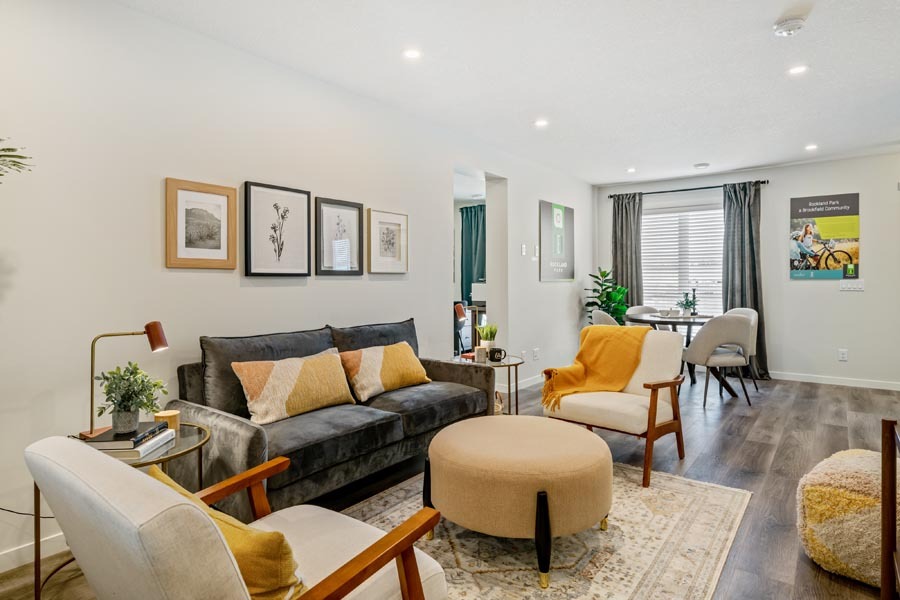The first step in creating an energy efficient home? Ensuring its building envelope is designed and built with efficiency in mind. When properly worked, thought out, and integrated, the building envelope of a home can dramatically improve its overall performance.
This article will break down some of the best practices when it comes to creating an energy-efficient building envelope, and how Avalon Homes incorporates these principles into their high-performance home designs.
Understanding an Energy-Efficient Building Envelope
A building envelope is all of the elements that separate the indoors from the outdoors; walls, roof, foundation, windows, doors, and insulation. It’s like the protective wrapping that keeps your conditioned air inside and outside air, moisture, and noise from penetrating through.
Creating an energy-efficient building envelope means optimizing these components to reduce energy consumption, improve indoor comfort, and support environmental sustainability.
With proper design and construction, a tight envelope minimizes heat loss in winter and heat gain in the summer, saving you money on energy bills and reducing your carbon footprint.
Essential Components of an Energy-Efficient Building Envelope
Air Sealing Techniques
One of the most wasteful mechanisms in homes when it comes to energy usage is air leakage. Small gaps and cracks around doors, windows, and other openings allow all that energy-rich air (be it warm or cool) to escape. This makes for a living environment that is inconsistent, and an HVAC system that is overworked.
- Materials: Caulking, weather stripping, and spray foam insulation for gap closure.
- Common Leak Points: Around windows and doors, electrical outlets, plumbing penetrations, and attics.
- Testing: A blower door test (which measures air leakage) can help identify areas that may be leaking and ensure your sealing techniques are effective.
Proper Insulation Installation
Without properly insulating your home, efforts to try and regulate the home’s temperature and reduce heating/cooling needs will be next to hopeless. Not all insulation is created equal, however, and poor installation can actually compromise its performance!
How to Optimize Installation
- Choose the right insulation: Options include fiberglass batts, cellulose, and spray foam…each of these has their own unique advantages.
- Careful installation: Ensure full coverage without gaps or compression (which can reduce effectiveness).
- Understand R-values: The R-value measures the material’s resistance to heat flow; the higher the R-value, the better the insulation.
High-Performance Windows and Doors
When it comes to having an energy-efficient building envelope, windows and doors are often the weak points. Upgrading to high-performance products is a must for energy efficiency. And, despite the higher up front investment, they will actually save you money long-term.
Key Features
- Double or triple glazing to reduce heat transfer.
- Low-emissivity (Low-E) coatings that reflect infrared heat.
- Proper installation and sealing to prevent drafts and moisture intrusion.
Common Mistakes to Avoid
When designing or upgrading your energy-efficient building envelope, you’ll want to be careful not to get stuck in these common pitfalls…
- Skipping thorough air sealing, which leads to drafts and energy loss.
- Poor insulation practices, such as leaving gaps or compressing batts.
- Using low quality windows and doors, which lowers the overall envelope performance.
- Neglecting moisture management, which can cause mold, rot, and structural damage.
If you want long-term comfort and durability, you have to pay attention to what’s listed above, or hire someone who can be trusted to do it for you!
Avalon Homes’ Approach to Building Envelopes
At Avalon Homes, prioritizing energy-efficient building envelopes is a cornerstone of our commitment to sustainability. We specialize in Net Zero and Net Zero Ready homes by using advanced techniques to create exceptionally airtight and well-insulated building envelopes.
Our approach to building envelopes includes using modernized framing techniques, meticulous air sealing, and rigorous quality checks at every step of construction. Our homes also typically have 50-60% more insulation than standard builds, resulting in a home that has better temperature regulation and less chance of developing mold or rot.
Third-Party Inspection
Avalon Homes enhances its building envelope protection by implementing a third-party inspection process during installation. This rigorous quality assurance measure ensures that the building envelope meets high standards, leading DuPont Canada to provide Avalon with an additional 10-year Limited Liability Warranty.
Key Benefits
- Extended Warranty Coverage – While the Alberta New Home Warranty Program offers a standard 5-year coverage, Avalon’s partnership with DuPont adds 10 more years of protection specifically for the building envelope.
- Third-Party Verification – Independent inspections during installation help ensure proper construction techniques and material application, reducing long-term risks.
- Enhanced Durability & Peace of Mind – Homeowners benefit from an extra layer of security against potential building envelope failures, such as water infiltration or air leakage.
This approach reflects Avalon’s commitment to quality construction and long-term homeowner satisfaction, going beyond minimum regulatory requirements
Carefully selected materials, attention to detail, and big picture mindset from first drawings is what separates Avalon from other custom home builders out there on the market today. If you’re looking for a well-constructed, one-of-a-kind home with an energy efficient building envelope and the custom features you’ve always dreamed of, contact us today!


